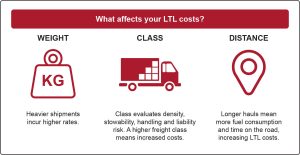If you’ve ever wondered how freight carriers determine the cost of shipping your goods (balancing complex factors like weight, distance, dimensions, and volatility) you’re not alone! In this post, we’ll unravel the key components that drive LTL pricing, exploring both the analytical tools that make it possible and the strategic finesse required to optimize costs. Whether you’re a seasoned supply chain professional or just dipping your toes into freight management, understanding these essentials will empower you to navigate this vital aspect of transportation with confidence and clarity. Buckle up as we embark on a journey through numbers and nuances that shape today’s LTL landscape!
Introduction to LTL Pricing
Navigating the world of freight LTL (Less Than Truckload) shipping can feel like decoding a complex puzzle. With its unique pricing structure, understanding how costs are calculated is crucial for businesses looking to optimize their logistics and savings. Whether you’re a seasoned shipper or just embarking on your shipping journey, grasping the intricacies of LTL pricing will empower you to make informed decisions that positively impact your bottom line. From weight and distance to hidden fees and discounts, this guide will demystify the art and science behind LTL pricing, helping you unlock better rates for your shipments.
Understanding the Basics: Weight, Class, and Distance
When it comes to freight LTL pricing, three key factors come into play: weight, class, and distance. Each plays a crucial role in determining your shipping costs.
Weight is straightforward—heavier shipments generally incur higher rates. Carriers often have specific thresholds that can influence the final price significantly.

Next is class. This classification system evaluates various aspects of the shipment, including its density, stowability, handling characteristics, and liability risk. A higher freight class means increased costs for shippers due to greater perceived risks or complexities involved in transportation.
Distance also affects pricing considerably. Longer hauls typically mean more fuel consumption and time on the road. Thus, as distance increases, so does the likelihood of rising expenses.
Understanding these fundamentals helps you anticipate charges better when planning your LTL shipments.
Accessorial Charges and Their Impact on LTL Pricing
Accessorial charges are additional fees that can significantly influence LTL pricing. These charges arise from services beyond basic transportation, adding complexity to your shipping costs.
Common accessorials include liftgate service, residential delivery, and inside pickup or drop-off. Each of these services comes with its own fee structure based on the additional effort required by the carrier.
Understanding these charges is essential for accurate budgeting. If you overlook them, you might face unexpected expenses that inflate your total shipment cost.
Moreover, not all carriers apply these fees uniformly. It’s wise to compare policies across different freight LTL companies before choosing a provider.
Being proactive about understanding accessorials helps in negotiating better rates. Clear communication with your carrier can also lead to customized solutions that minimize extra costs while meeting your logistics needs effectively.
Fuel Surcharges and How They Affect Rates
Fuel surcharges are a critical component of freight LTL pricing. They fluctuate based on the current cost of fuel, which can vary significantly from week to week. This means your shipping costs may not be as straightforward as they seem at first glance.
These surcharges are typically added to the base rate and calculated as a percentage. If fuel prices rise, so does the surcharge, impacting overall transportation expenses.
Understanding how these charges work is essential for budgeting your logistics effectively. Some carriers may use different formulas or benchmarks for calculating these fees, leading to variations in rates.
By keeping an eye on fuel price trends and knowing how each carrier applies their surcharge, you can make more informed decisions when selecting a provider. Remember that while you can’t control fuel prices, being aware of their impact helps mitigate unexpected costs down the line.
Exploring Discounts: Volume, Contract, and Negotiated Rates
Discounts in freight LTL can significantly reduce shipping costs. Understanding the types available is crucial for savvy shippers.
Volume discounts reward customers who consistently ship large quantities. If your business regularly sends out multiple shipments, negotiating a lower rate based on volume can lead to substantial savings.
Contract rates offer another avenue for cost reduction. By entering into an agreement with a carrier, you secure predictable pricing over time. This stability helps budget effectively and protects against market fluctuations.
Negotiated rates are tailored specifically to your needs. Engaging in discussions with carriers about your shipment frequency, weight, and routes often yields personalized deals that align better with operational demands.
Savvy businesses take advantage of these strategies to optimize their logistics expenses while ensuring swift delivery times.
Dimensional Weight: What it is and Why it Matters in LTL Pricing
Dimensional weight is a pricing technique that considers both the size and weight of a shipment. Unlike traditional shipping methods that focus solely on actual weight, dimensional weight takes into account how much space your package occupies in relation to its heaviness.
This metric becomes crucial in LTL freight because carriers often have limited space. A lightweight but bulky item can occupy valuable cargo area, leading to higher charges based on its dimensions rather than just its heft.
Understanding dimensional weight helps shippers optimize costs. By adjusting packaging or consolidating items, you can avoid unnecessary fees associated with excessive dimensional calculations. It’s all about maximizing efficiency while keeping expenses manageable in the competitive world of freight LTL services.
Hidden Fees and How to Avoid Them
Hidden fees can sneak into your freight LTL costs and create budget surprises. Many shippers overlook these charges, assuming the initial quote covers everything. However, additional fees can arise from various factors like reweighing shipments or residential deliveries.
To avoid unwanted costs, always request a detailed breakdown of quotes. Ask carriers about potential extra charges before committing to any service.
Another strategy is to understand the specific accessorials that may apply to your shipment type. Familiarity with terms like “liftgate service” or “inside delivery” can save you money when selecting services that meet your needs without unnecessary upsells.
Regularly review invoices against original estimates for discrepancies. If something seems off, don’t hesitate to challenge it with your carrier for clarification—this could lead to adjustments in future pricing as well! Keeping communication open will help minimize those hidden charges lurking in the fine print.
What are Accessorial Charges?
Accessorial charges, also known as additional services or fees, are extra costs associated with Less-than-Truckload (LTL) shipments beyond the base rate. These charges can significantly impact the overall cost of shipping and must be taken into consideration when determining pricing for an LTL shipment.
One common accessorial charge is a fuel surcharge. This charge is based on the fluctuating cost of diesel fuel and covers the carrier’s fuel expenses for transporting goods. The fuel surcharge is typically calculated as a percentage of the base rate and can vary depending on market conditions.
Another accessorial charge to be aware of is residential delivery or pickup fees. If a shipment needs to be delivered to or picked up from a residential area rather than a commercial location, carriers may charge an additional fee due to the extra time and effort required for these types of deliveries.
Additional handling fees are another common type of accessorial charge. This fee may apply if a shipment requires special handling such as oversize or fragile items, palletizing, assembly/disassembly, or inside delivery. Carriers may also impose this fee if their equipment needs to be used in conjunction with loading or unloading at pick-up or delivery locations.
Accessorial charges may also include specialized equipment fees. When certain shipments require specific equipment such as liftgates, temperature-controlled trailers, or flatbeds, carriers will likely add this charge to cover any necessary rental costs for specialized equipment.
Detention and waiting time charges are often assessed when there are delays during loading/unloading processes that are out of the carrier’s control. These charges apply when drivers have to wait longer than expected at pickup or delivery locations due to circumstances like long lineups or slow loading times.
Some less common but still important accessorial charges include reclassification fees (if actual weight differs from what was initially estimated), redelivery fees (if initial delivery fails due to consignee), storage fees (for holding shipments at carrier facilities), and limited access fees (if a delivery location is in a restricted or hard to reach area).
Understanding accessorial charges is crucial when determining the overall price of an LTL shipment. These extra costs are often overlooked but can significantly impact the final cost of shipping. It is essential to communicate openly with carriers and understand their specific accessorial charges before finalizing any shipment arrangements.
Tips for Getting the Best LTL Pricing for Your Shipment
To secure the best freight LTL pricing, start by consolidating your shipments. Fewer larger shipments can often qualify for better rates compared to multiple smaller ones.
Next, always measure and weigh your items accurately. Providing precise dimensions helps avoid unexpected charges later.
Consider flexible shipping dates as well. Carriers may offer lower rates during off-peak times, so scheduling strategically can lead to savings.
Don’t shy away from negotiating with carriers. Building a relationship over time could unlock discounts or improved service options tailored just for you.
Additionally, explore online freight marketplaces which allow you to compare multiple quotes in one place. This transparency makes it easier to find the most competitive prices available.
Lastly, stay informed about market trends and fuel costs since these factors heavily influence LTL pricing dynamics. Keep an eye out for seasonal fluctuations that might affect your rates too.
Choosing the Right Carrier based on Price vs. Service
When it comes to selecting the right carrier for your freight LTL needs, striking a balance between price and service is essential. While lower rates can be enticing, they might come at the cost of reliability or customer support. Consider what matters most for your business.
Evaluate potential carriers not just on their pricing but also on their track record with timely deliveries and communication. A slightly higher rate may provide peace of mind through better service levels, fewer delays, and enhanced tracking capabilities.
Ultimately, investing time into research will pay off when you find a carrier that meets both your budgetary constraints and operational needs. The goal is to establish long-term partnerships built on trust and efficiency—ensuring smooth operations as your business grows. Check out all that TOP Worldwide has to offer. We excel in Less than Truckload and can provide you with the value you need for your shipments.
 Jeff Berlin
Jeff Berlin
is the Chief Operating Officer of E.L. Hollingsworth & Co. and serves as the Senior Operations Executive for TOP Worldwide and Native American Logistics. With over 30 years of experience leading logistics and trucking companies, he brings deep industry expertise to his role. Jeff is also a CDL-A driver and a private pilot. Contact Jeff at jberlin@elhc.net.


